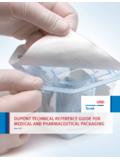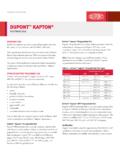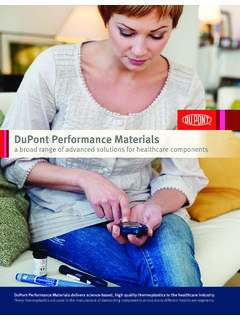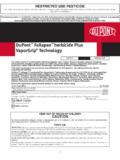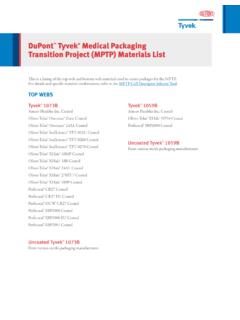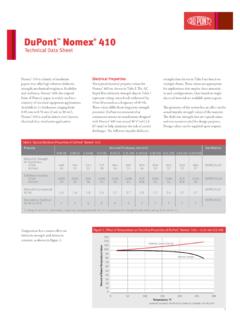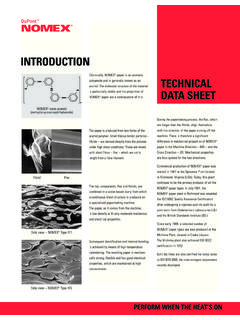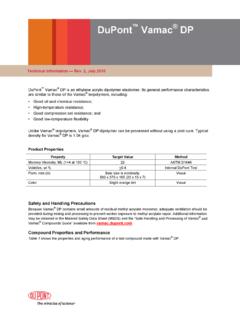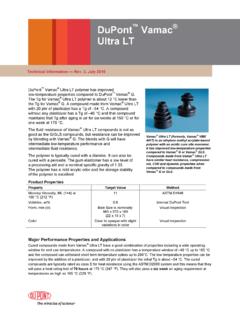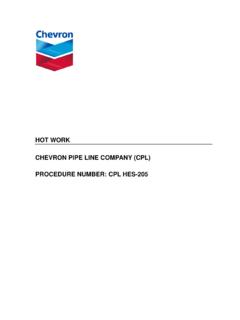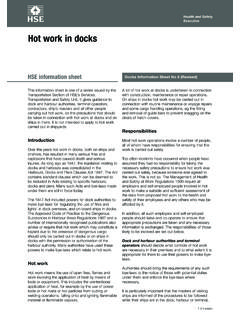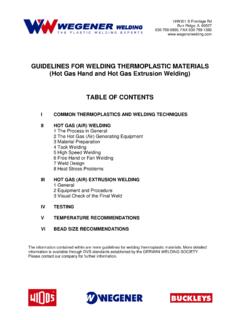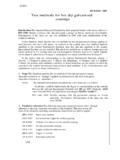Transcription of Mitigating Strategies for Hot Spots in Crystalline …
1 Mitigating Strategies for Hot Spots in Crystalline silicon solar panels Hot Spots Examples of damanged backsheets due to hot Spots are shown below. A tri-layer backsheet composed of Temperature Resistance of the Adhesion Layer of the Backsheet Hot Spots are areas of elevated temperature affecting solar panels generate significant power and hot Spots PVF/polyester/PVF presents an advantage over other Our field experience has shown that a Tedlar inner layer . only part of the solar panel. They are a result of a can occur when some of that power is dissipated in a backsheet constructions, in particular in partial shading can retain good adhesion to the EVA at high operating localized decrease in efficiency, which results in lower localized area. Hot Spots are rarely stable and will usually conditions. temperatures, as well as in hot spot conditions created power output and an acceleration of the materials intensify until total failure of the panel performance in by partial shading or underperforming cells.
2 Degradation in the affected area. terms of electricity production and/or safety. Partial shading of the cell by sand created a hot spot condition reaching 100 C (50 C above normal operating temperatures). The PVF-based backsheet suffered no damage and normal operation resumed upon cleaning. JIS K7196 Heat Deformation Test weighted stylus impinges on sample being heated, thermal transitions noted. TPT: Tedlar PVF/PET/Tedlar PVF; TPE: Tedlar PVF/PET/primer . The polyester-based backsheet shown below has Tedlar TPT backsheet does not show any sign . suffered from delamination of the outer coating and deep In addition to the acceleration of the aging mechanisms, of degradation under hot spot stress. Cleaning the panel in this case allowed a return to normal cracks through the entire depth of the backsheet. The the temperature resistance of the inner layer (the layer operating conditions. electrical insulation of this backsheet was compromised. in the backsheet which ensures durable adhesion to the We have also observed delamination of polyester-based The polyvinyl difluoride (PVDF)-based backsheet encapsulant) is a factor of prime importance in retaining backsheets, as well as PVDF-based backsheets, Soiling can have dramatic consequences on the shown below also suffered deep cracks, compromising the adhesion of the insulation layer to the EVA at the consistent with a lower temperature resistance of the safe operation of the park as well as its operability.
3 The electrical insulation of the panel. In addition, the back of the panels . adhesion layer to the EVA. backsheet suffered from yellowing and surface cracking. High temperatures can accelerate the Tedlar /PET/Tedlar or TPT backsheet has Tedlar . degradation of backsheets PVF as an adhesion layer. This material exhibits the highest temperature resistance of all the backsheets Hot Spots can occur as a result of the park operation, studied here while providing optimum UV and in particular when operating in hot, dry areas prone moisture resistance. to sanding and dusting. Hot Spots are caused by underperforming cells. The cell will dissipate the current Polyvinyl difluoride (PVDF) backsheets exhibit produced by the string and behave like a resistor, varying degrees of temperature resistance according Polyester-based backsheet PVDF-based backsheet Hot Spots are evident in this infrared photo showing elevated temperature where the cells are damaged along the frame. converting current into heat.
4 The higher resulting to the formulation and manufacturer of the PVDF. Backsheets with low inner layer softening temperatures temperature of the cell (heat) will accelerate aging Therefore, this material exhibits variable properties can be expected to delaminate in addition to the mechanisms of the Matter neighboring materials, in particular that can impact its suitability for the field. accelerated aging shown before. Materials Materials Matter . Polyester-based backsheet PVDF-based backsheet of the encapsulant and the backsheet. Main Causes of Hot Spots Materials Mitigating Strategies FORM atter HOT Spots IN HOT. Crystalline . Spots IN silicon solar Examples of backsheet damage in hot spot conditions. PANELSSOLAR panels .. Mitigating Strategies FOR Crystalline silicon . MaterialsSTRATEGIES. Matter FOR HOT Spots IN Crystalline silicon solar panels . Bypass Diodes to Mitigate Hot Spots . Mitigating . Mitigating Strategies FOR HOT Spots IN Crystalline silicon solar panels . There are multiple causes of hot Spots , and they can be Installing panels in landscape orientation will enable functional or operational.
5 The functional reasons can be the bypass diodes to work and enable the generation Impact Impact of of Spots Impact Hot Hot Spots of Hot onSpots onthethe on Electrical Protection of the Panel Electrical the Electrical Bypass diodes are designed to cut out an divided into two areas: of 10 percent electricity, even in winter. Impact of Panel Hot Spots on the Electrical underperforming string of cells to guarantee power Protection Protection of the of the Panel Cell mismatch occurs when cells of varying current Impact The consequences of Hot of hot Spots Spots canon theMatter range Materials Electrical from dramatic production from the rest of the panel. An operating . Rooftop Conditions fires Protection to accelerated aging of the ofspots the Panel materials Mitigating Strategies FOR HOT Spots IN Crystalline silicon solar panels . and, infiresmost production are connected in series. The consequences The consequences of hot Spots of hot can range fromcan range from dramatic firesdramatic to to bypass of a string containing an underperforming cell Rooftops can present challenges.
6 When cells are cases, acceleratedwe Protection will aging The of see accelerated the aging materials consequences of theofmore the ofand the inspots Panel diffuse hotmaterials and mostcan cases,temperature in rangewemost cases, will see from increase thewe will dramatic firessee to the will also prevent overheating of the cell acting as a Cell damage can occur during the production completely shaded (by design of the system), this may more diffuse temperature increase leading to an more diffusetotemperature leading accelerated The increase anconsequences accelerated aging leading hotaging ofofthe to can anof materials Spots accelerated andthe in most Impact range from ofaccelerated aging backsheet/. cases, of weSpots Hot dramatic will aging firessee theof toon the Electrical resistor. Our experience of hot Spots in the field shows us process because the silicon cell will be subjected not be sufficient to trigger the bypass diode, resulting the morebacksheet/encapsulation the backsheet/encapsulation diffuse material temperature set material (Fig.)
7 4). increaseand set leading (Fig. 4). to ancases, accelerated aging see theof encapsulation material accelerated aging set. of the materials Protection in most ofwethe willPanel numerous examples where bypass diodes are indeed not to many stresses during lamination, handling in increased temperature which will degrade the panel. the morebacksheet/encapsulation material diffuse temperature increase set (Fig. leading to an4). accelerated aging of A hot A hotspot spot Aresulting hot spot resulting fromresulting or from, leading from to or aor leading short leading toThe circuit abetween to, short circuit consequences a short of hotbetween the thefrom dramatic fires to Spots can range circuit functioning as in the field. and transportation. Partial shading due to trees or tall vegetation should front and the the backsheet/encapsulation material setin(Fig. 4). accelerated aging of the materials and in most cases, we will see the front back A hotand of thethe spot back cell willofresult resulting the cell from or will localized in very leadingresult to a very high short localized circuit highleading between the Delamination of PVDF-based backsheet on 134 C hot spot.
8 Be controlled. between the front and the back of the more cell will result diffuse temperature increase insetveryto an accelerated aging of In this example, we dismantled the junction box to The operational reasons for hot Spots are related to intensity intensity heating. This front A hotand heating. type the of This hot type spot back ofheating. can the cellof hot result spot willThisin result can melting the result ainshort veryof of in melting backsheet/encapsulation localized of material high can (Fig. 4). localized high intensity spot resulting from or leading to type hot circuit spot between the Hot Spots Lead to Bubbling leading to a short circuit between the Hot Spots Lead to Bubbling examine the interior. We found visually undamaged the solar park design and operation, and can include: Soiling the backsheet the backsheetintensity and frontcan and lead the and to heating. back can fires. This of lead type the to of cell fires. hot will spotA. result hot can in spot resulting result very in from localized or meltinghigh of result in melting of the backsheet and frontcan lead and the back of theto fires.
9 Cell will result in very localized high Hot Spots Lead to Bubbling bypass diodes; however, the diodes were unable to the backsheet intensity andThis heating. can lead typeto offires. hot spotintensity can result heating. in Thismelting type of hot of Hot spot can result in melting of Spots lead to bubbling Winter Shading panels can be soiled due to dust, dirt and other the backsheet and can lead to fires. Hot Spots Lead to Bubbling Hot Spots Lead to Bubbling prevent the hot spot that damaged the backsheet. the backsheet and can lead to fires. An EPC company may want to accept shading conditions contaminants during their lifetime. The O&M company In this case, the bypass was not triggered, showing in winter to increase electricity production in summer. should also identify situations requiring cleaning, either that the diode did not function as expected or panels will suffer systematic shading of the bottom row which means regular visits to the park. The frequency Materials Matter.
10 That the diode had not reached the designed reverse of cells every morning and evening during winter. of cleaning will be heavily dependent on the climate Mitigating Strategies FOR HOT Spots IN Crystalline silicon solar panels bias for operation. In all cases, the non-operation conditions and ground surrounding the park. Deep Crack Micro Crack of the bypass should be considered as a failure. (Polyester) (Polyester). Deep Crack Deep Crack Crack Micro MicroImpact of HotCrack Spots on the Electrical However, we have also encountered situations (Polyester). (Polyester) Deep (Polyester). (Polyester) Micro where although the bypass was triggered, it resulted Crack Protection of the Panel Crack The Temperature Challenge (Polyester). Deep Crack (Polyester). Micro The consequences Crack of hot Spots can range from dramatic fires to in overheating of the diode and subsequent melting (Polyester) (Polyester) and in most cases, we will see the accelerated aging of the materials more diffuse temperature increase leading to an accelerated aging of Bubbling Leads to Cracking of the junction box.
